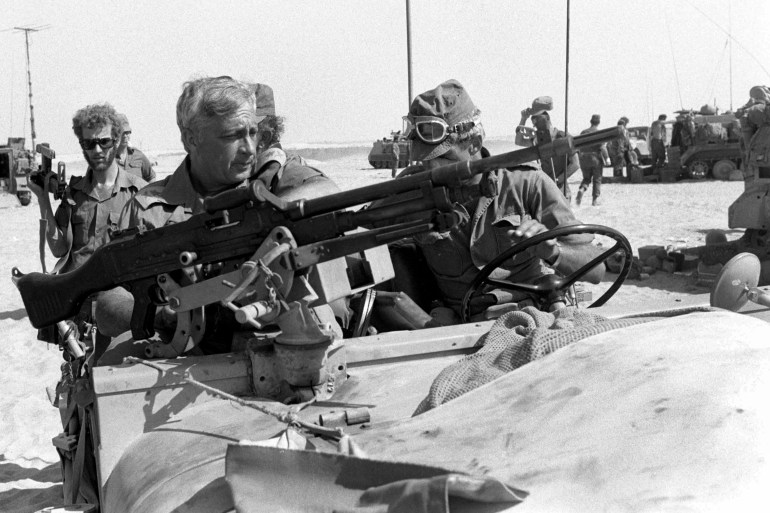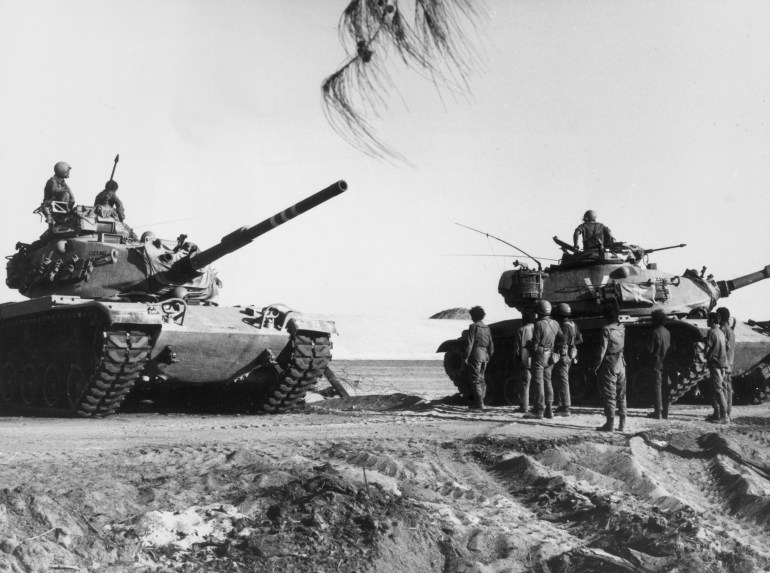It was speculated to be impenetrable, the steep, 21-metre (70-foot) wall of sand dotted with closely armed strongholds – trying to breach it, a suicide mission.
Or so the Israelis thought.
They calculated that the Bar Lev Line, a 150km (93-mile) sand embankment that stretched from the Gulf of Suez to the Mediterranean Sea, would take 12 hours to pulverise with explosives – sufficient time to ship reinforcements.
However when the Egyptians got here on October 6, 1973, they pounded it down in simply three hours, utilizing water pumps.
“A couple of minutes after 1420 hours, because the canisters started to belch clouds of protecting smoke, our first assault wave was paddling furiously throughout the canal, their strokes falling into the rhythm of their chant, ‘Allahu Akbar…Allahu Akbar…’,” wrote Lieutenant Normal Saad el-Shazly, an Egyptian army commander at the moment, in his 1980 account of the occasions titled, The Crossing of the Suez.
“[Our] plane skimmed low over the canal, their shadows flicking throughout enemy strains as they headed deep into the Sinai,” el Shazly continued. “For the fourth time in my profession, we had been at struggle with Israel.”
The assault was timed with one other within the north, a battalion of Syrian forces that launched an assault to take again the Golan Heights.
Israeli forces had been aghast. Yom Kippur was being noticed within the Jewish state and Ramadan elsewhere within the Center East, however that didn’t deter the beginning of Operation Badr.
Using excessive on the victory of capturing territory 4 instances its dimension within the 1967 Arab-Israeli struggle, Israel by no means anticipated an assault like this.
This primary battle spiralled into the bloody 19-day struggle recognized by a number of names: the October Warfare, the Yom Kippur Warfare, the Ramadan Warfare, or the 1973 Arab-Israeli Warfare.
Fifty years later, it’s clear the struggle modified not simply the area and the way forward for Arab-Israeli relations, but additionally the world, because it rocked the orbit of the Chilly Warfare, altering the US’s strategy to the Center East.
‘Egypt’s most interesting hour’
Tewfick Aclimandos was simply 14 years previous when the struggle started however he has important, if obscure, recollections of it.
Neither a hit nor a failure, it was nonetheless “Egypt’s most interesting hour”, Aclimandos, director of the European research unit on the Egyptian Middle for Strategic Research and professor on the College of Cairo, informed Al Jazeera.
Taking again the Sinai Peninsula from Israel was a victory that cemented the Egyptian military’s would possibly underneath the management of President Anwar Sadat, he stated. It gave legitimacy to each successor of Sadat’s who took half within the struggle effort, he added.
“We’re the founding fathers, we’re the protectors of Egypt,” was the military’s messaging after taking again the Sinai, Aclimandos recalled.
It’s no marvel, then, that within the years following it, the anniversary of the struggle is well known extensively, from free entry to army museums on October 6 to ceremonies and parades.
Simply as targeted as Cairo was on taking again Sinai, so too was Damascus on the Golan Heights. Israel had captured each within the 1967 struggle, alongside occupying what remained of Palestine.
Situations had been ripe for the October Warfare within the Arab thoughts: An Arab entrance heading into battle to avenge the struggling of Palestinians and to take again their very own territories.
Nonetheless, the occasions of the October Warfare didn’t advance the Palestinian trigger. In response to Sami Hamdi, the managing director at Worldwide Curiosity, a political danger agency specializing in the Center East, it was, actually, “a powerful failure” in that regard.
“Arab states restoring justice for Palestine was fully blown aside by the October Warfare,” he informed Al Jazeera.
Whereas it was believed that the 2 strongest armies within the area on the time would have the ability to push again towards the Israeli occupation, the struggle as a substitute ended with Egypt normalising relations with Israel, defined Hamdi.
Cairo and Damascus waged the struggle for his or her self-interests and the Palestinian trigger was secondary, he argued.
Arab management within the area, because of this, was fully “damaged” by the occasions of the struggle, he stated.

A united Arab entrance, splintered
The struggle demonstrated, nevertheless, {that a} united Arab entrance may very well be leveraged to spur motion on the world stage.
When the tide of struggle turned in favour of Israel and preventing got here to an deadlock 12 days into the battle, the Arab oil-producing international locations, underneath the Group of Petroleum Exporting Nations (OPEC), determined to cut back their oil manufacturing by 5 %.
The states declared they’d keep the identical price of discount every month till Israeli forces withdrew from Arab territories occupied in 1967, and the rights of Palestinians had been restored. In addition they enforced an embargo on the US, suspending oil provide.
These actions had oil costs hovering – and affected the trajectory of the Chilly Warfare.
The Soviets had been supplying the Arab states with weapons, whereas the US backed Israel, however the embargo had the US scrambling for options to the battle.
“This was additionally a chance to push away [the Soviets],” Yossi Mekelberg, an skilled on Israel at Chatham Home, informed Al Jazeera.
Thus, Henry Kissinger swooped in, the previous US nationwide safety adviser shuttling from Cairo to Damascus, to Tel Aviv in an try and forge Arab-Israeli peace.
His “shuttle diplomacy” – as his scuttling peacemaking was termed – labored, because it introduced a ceasefire that will finish the struggle, stated Mekelberg.
Nimrod Goren, senior fellow for Israeli affairs on the Center East Institute, agreed, saying the occasions had been momentous in shifting the world from an period of struggle to an period of diplomacy,
“It was a watershed second,” he informed Al Jazeera.
However the Kissinger-fronted US diplomacy with particular person international locations was precisely what splintered a united Arab entrance, stated Hamdi.
For instance, Hamdi stated, Kissinger in all probability informed the Egyptians, “I can persuade the Israelis to surrender Sinai”.
As such, he made a concerted effort to construct relations based mostly on particular person pursuits that finally outdated pan-Arab ties, the analyst defined.
This could be mirrored within the coming years, notably within the Gulf Warfare of 1990, stated Hamdi, when Iraq invaded Kuwait and a US-led coalition, which included different Arab states, got here to Kuwait’s defence.

The trek in direction of Arab-Israeli peace
Kissinger’s shuttle diplomacy ultimately reduce Egypt off from the Arab fold when Cairo normalised relations with Israel.
Within the aftermath of the struggle, Sadat tried to interrupt the impasse of Arab-Israeli peace agreements, stated Mekelberg.
In 1977, the previous Egyptian president appeared in Jerusalem to provide a speech on peace to the Israeli parliament, the primary Arab chief to go to Israel.
That was adopted by the signing of the Camp David Accords in 1979, on the behest of US President Jimmy Carter, who invited Sadat and then-Israeli Prime Minister Menachem Start to a retreat in Washington.
The accords had been the idea for the Egyptian-Israeli peace treaty – which shook Egypt unfastened from the Arab League fold.
“Egypt had offered out the Palestinians” was the widespread sentiment, stated Hamdi.
Sadat’s place, in the meantime, was that Egypt had accomplished its finest to battle two wars for the Palestinian trigger and couldn’t be anticipated to ship justice alone, the analyst stated.
The peace treaty, subsequently, was to get Israel off its again, whereas its leaders and populace nonetheless harboured deep resentment in direction of the Israeli occupation, Hamdi defined.
Israel, for its half, was additionally invested in patching issues up with Cairo – its greatest lesson from the struggle was the need of peace with its neighbours, stated Goren.
The 1967 struggle had bloated Israel’s confidence in its army would possibly, and the not too long ago shaped state was satisfied it was invincible, stated Mekelberg. The October Warfare modified that notion shortly.
There was little success in Arab-Israeli peace within the 50 years for the reason that struggle, nevertheless, the Israeli-Egypt peace treaty no less than stays intact for essentially the most half, Goren stated.
For the Egyptian commander on the struggle’s entrance strains, the struggle and its ensuing covenants had been justified.
“One could also be aggressive; one could have risked one’s life for one’s nation. However why ought to that predispose one to gamble with the way forward for the armed forces and the destiny of 1’s nation?” el-Shazly wrote.


